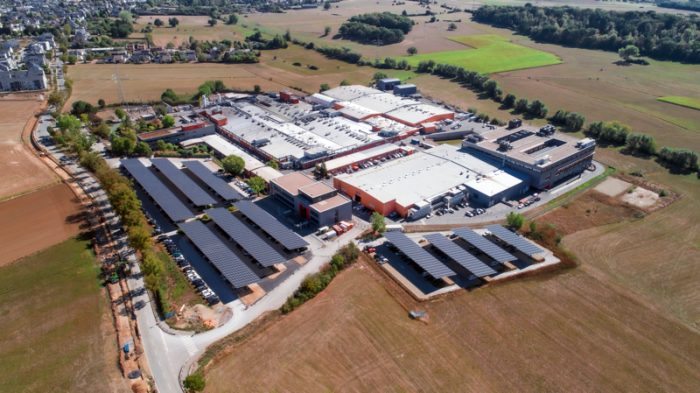CERATIZIT executes its sustainability strategy with the opening of new solar carport in Luxembourg

CERATIZIT has opened Luxembourg’s largest solar carport in Mamer. With over 1.25 Gigawatt hours (GWh) of electricity produced from sustainable sources each year, the plant generates enough power to cover the consumption of 415 households. The opening ceremony – attended by Prime Minister Xavier Bettel and Energy Minister Claude Turmes – was the ideal opportunity for the company to present its ambitious sustainability strategy, with which it aims to take a leading role among carbide and precision tool manufacturers by 2025.
The carport in the employee car park in Mamer – a joint project with Luxembourgian/Belgian company Enerdeal – is an example of how car parks and other spaces can be used to boost sustainability; it also demonstrates how they can contribute to generating more green electricity in Luxembourg and thus help the country become less dependent on foreign imports. “The project shows that we as an industry can be an important part of the solution in slowing climate change on many levels, specifically in terms of sustainability,” explains board member Frank Thomé.
More than 3 GWh of additional potential
With this in mind, CERATIZIT is planning to open further solar plants in future. “There is potential to install further photovoltaic systems with a yearly capacity of over 3 Gwh at our Luxembourg sites in Mamer, Livange and Niderkorn. That’s why we are already in the process of planning the next projects today,” says Thomé on the company’s future plans.
Leading role in sustainability
The photovoltaic projects are an integral part of CERATIZIT’s ambitious sustainability strategy, which also requires a rethink in many areas of the company itself. In order to facilitate this major change, CERATIZIT has consciously set itself ambitious targets, as board member Thierry Wolter explains: “Our vision is to be a leader in the area of sustainability in the carbide and cutting tool industry by 2025.”
At the same time, he underlines the important role politics has to play in ensuring the industry can succeed in becoming more sustainable. “Our society cannot function without the economy. This is why we always need to view reduction targets in the context of the current economic conditions. They need to promote sustainability while at the same time ensuring that industrial production in Luxembourg remains competitive,” continues Wolter.
Sustainability along the entire value chain
Preparations are already being made for this within the company. In order to become truly sustainable throughout the company, CERATIZIT will consider the whole value chain in future, including collaboration with partners, with regard to environmental, social and governance criteria (ESG). During the first phase, the focus will be on aspects that have the greatest leverage.
Reducing the carbon footprint.
In order to quickly and drastically reduce our own carbon footprint, CERATIZIT will begin with three key ‘levers’. One crucial factor will be to increase the proportion of raw materials that stay in the production chain to over 95%. Preparing secondary raw materials requires 70% less energy and provides a 40% reduction in the carbon footprint compared to the use of primary raw materials from mining. A positive side effect of this is that it will secure the supply chain for raw materials, which not only benefits CERATIZIT but also our customers.
Power supply will also be considered. CERATIZIT plans to switch the power supply at all sites to green electricity from wind, solar and hydropower in the coming years.
Closely linked with the change of power supply is the issue of hydrogen supply. CERATIZIT requires large quantities of hydrogen, particularly for the production of tungsten powder, which is done in Niederkorn and at other sites. Until now, the hydrogen required has been obtained via steam reforming from natural gas, known as ‘grey’ hydrogen. In future, CERATIZIT is planning to switch to green hydrogen, which is obtained from water via an electrolysis process that uses green electricity. CERATIZIT will cooperate with its current suppliers on this, as well as developing its own electrolysis plants.
Milestone: carbon neutral by 2025
The first milestone in the implementation of the new strategy is set for 2025. CERATIZIT plans to be carbon neutral by this point. This doesn’t just mean offsetting all emissions generated along the whole supply chain, however. CERATIZIT also plans to reduce actual emissions by 35% compared to the reference year of 2020. For the second stage, 2030, the company is planning further measures to achieve a reduction of 60% compared to 2020.
However, the most ambitious goal is to be ‘net zero’ by 2040 – a goal taken from the Paris Agreement, set for 2050. “To reduce the carbon emissions by 75% across the whole value chain by 2040 is undoubtedly a huge challenge. Thinking of future generations, however, we don’t see any alternative options and are looking forward to playing our part with innovative products and a wide range of services. And we also want our customers to be a part of it,” says Wolter, describing the company’s motivation.
For more information, please visit http://www.ceratizit.com.
News Categories
- » NEWS HOME
- » Automation & Robotics
- » Industry 4.0
- » Material Handling
- » Sensors
- » Quality & Testing
- » Machine Vision
- » Laser & Optics
- » Metalworking
- » Motion Control & Drives
- » Hydraulics & Pneumatics
- » Process Industry
- » Renewable Energy
- » Agriculture
- » Home & Office Furniture
- » Environmental Tech



